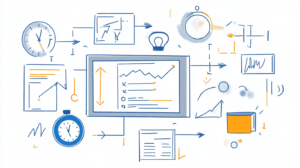Timing Out? Here’s How to Manage Session Expirations

In the digital world, timing out is a critical aspect of session management that affects both user experience and security. Whether it’s a session timeout due to inactivity or a connection timeout caused by network issues, understanding how timing out works is essential for both users and administrators. This article delves into the various types of timeouts, their implications, and how to manage them effectively to ensure smooth and secure online interactions.
Table of Contents
- What is Timing Out?
- Types of Timeouts
- Why Timeouts Matter
- Managing Timeout Settings
- Common Timeout Errors
- How Deskcove Helps with Session Management
- FAQ
What is Timing Out?
Timing out refers to the process where a session, connection, or process ends automatically after a specified period of inactivity or failure to receive a response. This mechanism is designed to enhance security and optimize system resources. In web applications, for example, a session timeout occurs when a user is logged out after a period of inactivity, ensuring that unauthorized users cannot access the session if the user leaves their device unattended.
Importance of Timing Out
The concept of timing out is crucial in maintaining security and resource efficiency. By automatically ending sessions that are idle or connections that are unresponsive, systems can prevent unauthorized access and free up resources for other active processes. However, incorrect timeout settings can lead to user frustration, especially if sessions expire too quickly or connections are frequently dropped.
How Timing Out Works
Timing out is managed through predefined settings in an application’s configuration. These settings define the duration of inactivity allowed before a session or connection is terminated. For instance, a session timeout might be set to 30 minutes, meaning if the user is inactive for that period, they will need to log in again. Understanding and configuring these settings appropriately is vital for both user experience and system security.

Types of Timeouts
There are several types of timeouts that can occur in various contexts, each with its own implications and management requirements. The most common types include session timeouts, connection timeouts, and inactivity timeouts.
Session Timeout
A session timeout occurs when a user’s session on a web application or system ends due to inactivity. This is typically used as a security measure to prevent unauthorized access if a user leaves their device unattended. For example, in a banking application, a session timeout might occur after 15 minutes of inactivity to ensure that sensitive financial information is not accessible if the user steps away.
Connection Timeout
Connection timeouts happen when a connection to a server or network cannot be established within a predefined time frame. This can be due to network issues, server overload, or incorrect settings. Connection timeouts are critical in maintaining system performance, as they prevent prolonged attempts to establish a connection that is unlikely to succeed, allowing the system to focus on other tasks.
Inactivity Timeout
Inactivity timeouts are similar to session timeouts but are more focused on individual components within a system, such as specific tasks or processes. An inactivity timeout might occur if a user starts a file download but does not interact with the download process for a set period. This prevents system resources from being tied up with tasks that are no longer active, improving overall efficiency.
Why Timeouts Matter
Timeouts play a crucial role in both security and user experience. They protect systems from unauthorized access, ensure that resources are used efficiently, and help maintain overall system performance. However, balancing these benefits with user convenience is essential, as overly aggressive timeout settings can lead to frustration and decreased productivity.
Security Considerations
From a security perspective, timeouts are vital in preventing unauthorized access to sensitive information. If a user leaves their workstation unattended, a session timeout ensures that their session will end, reducing the risk of someone else accessing their data. Similarly, connection timeouts can prevent malicious actors from repeatedly attempting to connect to a system, thereby reducing the risk of unauthorized access.
User Experience
While timeouts are important for security, they can also impact user experience. If a system times out too quickly, users may find themselves repeatedly logging in, which can be frustrating. On the other hand, if timeouts are too lenient, they might compromise security. Finding the right balance between security and convenience is key to optimizing timeout settings.
Managing Timeout Settings
Proper management of timeout settings is crucial for maintaining a secure and user-friendly system. Administrators need to carefully configure timeout durations based on the needs of their users and the sensitivity of the information being protected.
Configuring Session Timeouts
When configuring session timeouts, consider the balance between security and user convenience. For highly sensitive applications, shorter timeout durations may be appropriate, while for less critical applications, longer timeouts can be set to improve user experience. Regularly reviewing and adjusting these settings based on user feedback and security requirements is essential for optimal performance.
Connection Timeout Settings
Connection timeouts should be configured to prevent prolonged attempts to connect to a server or network that is not responding. This not only frees up system resources but also improves user experience by providing quicker feedback when a connection attempt fails. Administrators should set these timeouts based on typical network performance and system requirements.
Inactivity Timeout Adjustments
Inactivity timeouts should be tailored to the specific processes they are protecting. For example, a file download might require a longer inactivity timeout than a simple data entry task. Adjusting these settings based on the nature of the task and the user’s interaction patterns can help optimize system performance and user satisfaction.

Common Timeout Errors
Despite careful configuration, users may still encounter timeout errors, which can be frustrating and disruptive. Understanding these errors and knowing how to troubleshoot them can help minimize their impact on user experience.
Session Timeout Errors
Session timeout errors occur when a user is logged out of an application due to inactivity. This can happen if the timeout duration is too short or if the user is unaware that their session is about to expire. To mitigate these errors, consider implementing session warnings that alert users before their session expires, giving them the opportunity to extend their session if needed.
Connection Timeout Issues
Connection timeout errors typically occur when a server or network fails to respond within a set timeframe. This can be caused by network congestion, server overload, or incorrect configuration settings. Troubleshooting these errors involves checking the network connection, reviewing server performance, and adjusting timeout settings as necessary.
Inactivity Timeout Problems
Inactivity timeout errors can disrupt tasks that require prolonged periods of inactivity, such as file downloads or system updates. To prevent these errors, consider increasing the inactivity timeout for specific tasks or processes that are known to require more time. Regularly reviewing and adjusting these settings based on user feedback can also help reduce the occurrence of inactivity timeout errors.
How Deskcove Helps with Session Management
Deskcove offers advanced session management features that allow administrators to customize timeout settings according to their organization’s needs. With Deskcove, you can configure session timeouts, connection timeouts, and inactivity timeouts with ease, ensuring that your systems are secure without compromising user experience. Additionally, Deskcove provides real-time alerts and monitoring tools to help you identify and address timeout-related issues quickly and effectively.
FAQ
What is a session timeout?
A session timeout is a security feature that automatically ends a user’s session after a period of inactivity. This helps prevent unauthorized access to the session if the user leaves their device unattended.
How can I prevent connection timeout errors?
To prevent connection timeout errors, ensure that your network is stable and that your server is not overloaded. You can also adjust the connection timeout settings to allow more time for the connection to be established.
What should I do if I encounter a timeout error?
If you encounter a timeout error, check your internet connection, try reloading the page or application, and verify that your timeout settings are correctly configured. If the problem persists, contact your system administrator for further assistance.
For more information on how Deskcove can help you manage session timeouts and improve your system’s security and performance, visit our website or contact our support team.
